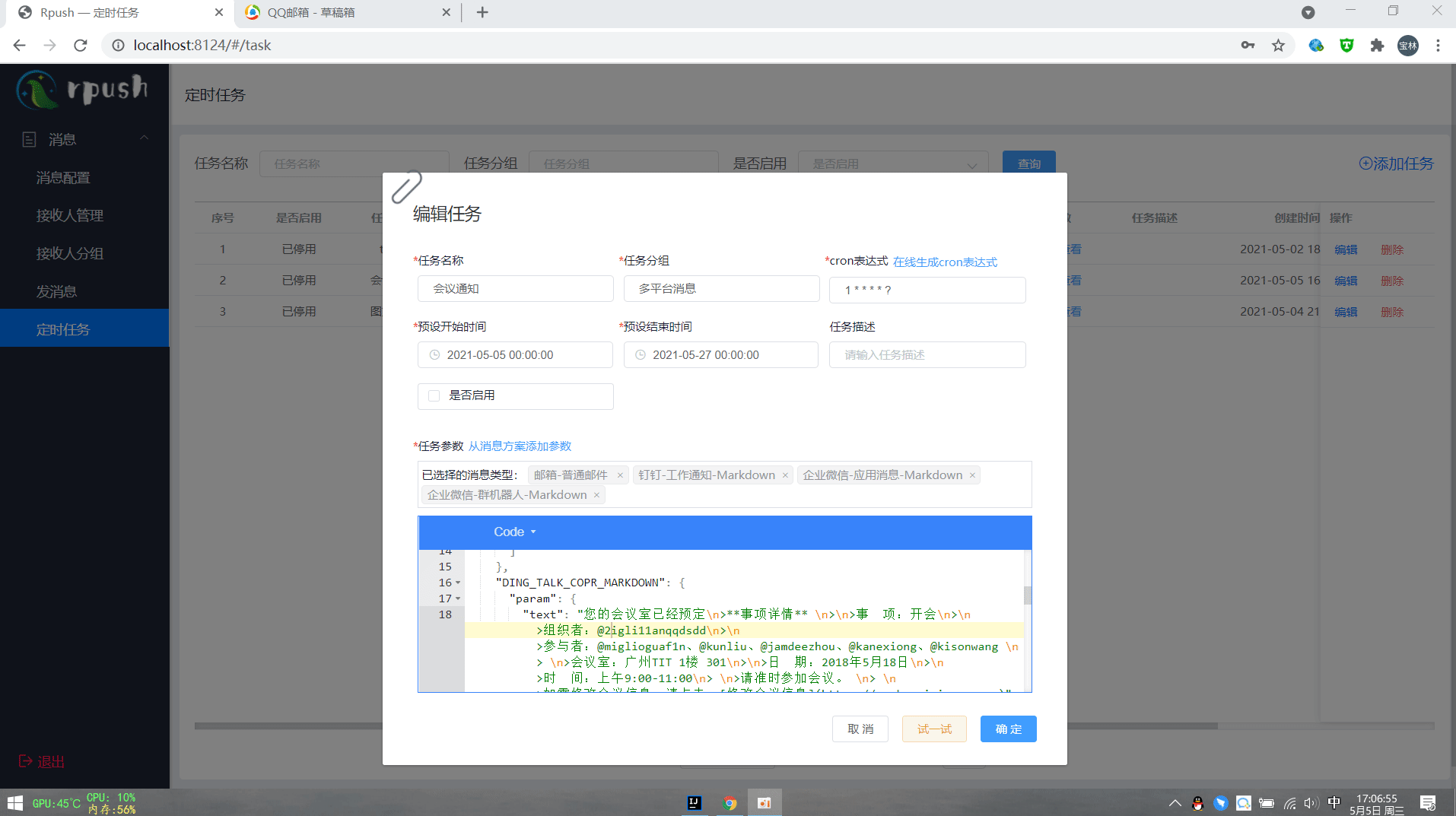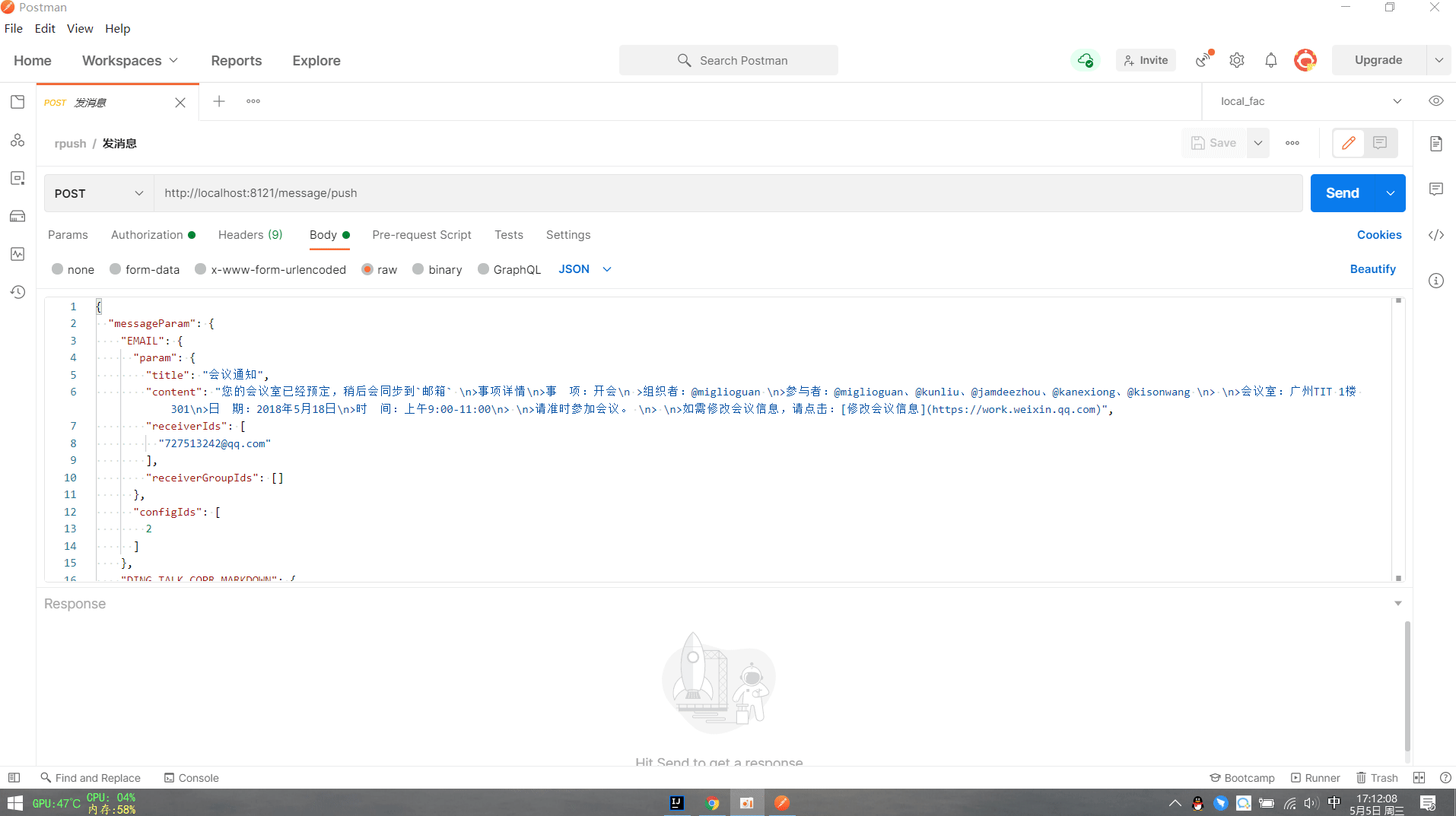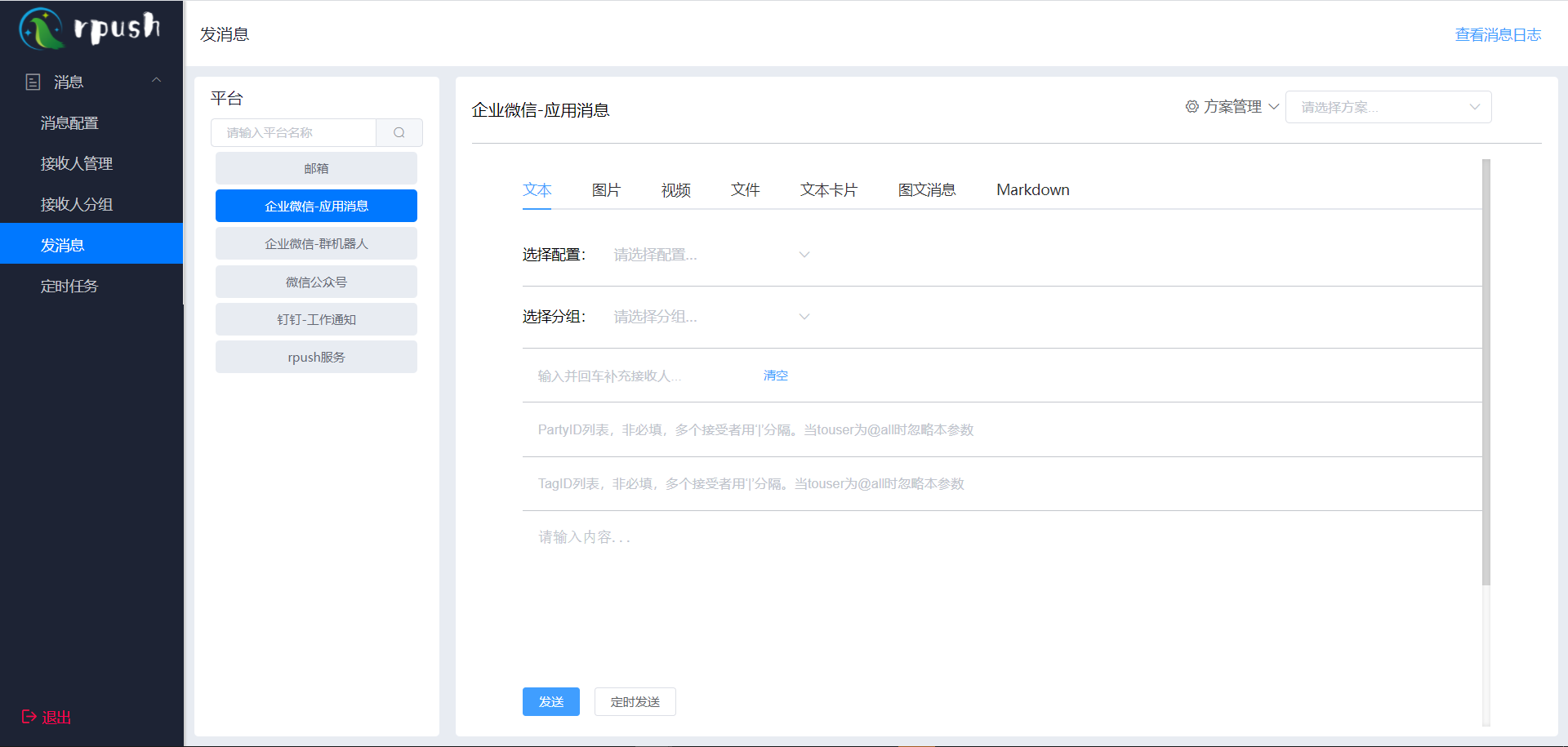一个接口触达多平台(包括微信公众号、企业微信、钉钉、邮箱等任何想的到平台,都能一个接口一次推送;极简的代码调用,极大减少业务方消息推送的代码量); 同时提供基于netty和websocket的即时通讯实现,实现单聊、群聊等功能。开箱即用,采用SpringCloud微服务架构,扩展简单且没有单点问题。致力于包揽所有和消息推送有关的技术开发工作,节省开发资源。
http://159.75.121.163/ admin admin
Rpush的架构决定了扩展一个消息平台的消息类型会非常简单,所以如果要扩展一个消息平台,大部分时间都会花在查找该平台的对接文档上。后续会在工作之余加上其它的平台或消息类型。当然,欢迎参与扩展(扩展一个消息平台的消息类型,只需要几个java类即可,不需要写任何前端代码,即可获得包括ui交互内的所有功能)。
本地数据库执行sql/表结构.sql初始化数据库,初始化好数据库之后,到rpush-route/src/main/resources/application.yml把数据库连接配置改成自己的数据库。然后分别启动以下3个类:
启动完成之后,浏览器打开http://localhost:8124就能显示界面并得到一个完整的消息分发功能



秉持”业务服务只负责发消息“的解耦原则,业务服务在需要发消息的时候,代码应该越简单越好。所以,Rpush的发消息的sdk,一种消息只需要一行代码,有几种消息就有几行代码。比如这样:
/**
* @author shuangmulin
* @since 2021/6/8/008 11:37
**/
public class RpushSenderTest {
/**
* 要发送的内容
*/
public static final String content = "您的会议室已经预定 \n" +
">**事项详情** \n" +
">事 项:开会\n" +
">组织者:@miglioguan \n" +
">参与者:@miglioguan、@kunliu、@jamdeezhou、@kanexiong、@kisonwang \n" +
"> \n" +
">会议室:广州TIT 1楼 301\n" +
">日 期:2021年5月18日\n" +
">时 间:上午9:00-11:00\n" +
"> \n" +
">请准时参加会议。 \n" +
"> \n" +
">如需修改会议信息,请点击:[修改会议信息](https://work.weixin.qq.com)";
public static void main(String[] args) {
// 企业微信-markdown消息
MarkdownMessageDTO markdown = RpushMessage.WECHAT_WORK_AGENT_MARKDOWN().content(content).receiverIds(Collections.singletonList("ZhongBaoLin")).build();
// 企业微信-群机器人消息
TextMessageDTO text = RpushMessage.WECHAT_WORK_ROBOT_TEXT().content(content).receiverIds(Collections.singletonList("ZhongBaoLin")).build();
// 邮箱
EmailMessageDTO email = RpushMessage.EMAIL().title("会议通知").content(content).build();
RpushService.instance("baolin", "666666").sendMessage(markdown, text, email); // 填上账号密码,运行即可
}
}
以上代码,一次发送了三种不同平台的不同消息类型,全部代码加起来也只需要四五行代码而已。要获得以上效果,只需要maven引用rpush的sdk模块即可:
<project>
<!-- 设置 jitpack.io 仓库 -->
<repositories>
<repository>
<id>jitpack.io</id>
<url>https://jitpack.io</url>
</repository>
</repositories>
<dependencies>
<!-- 添加rpush-sdk依赖 -->
<dependency>
<groupId>com.github.shuangmulin.rpush</groupId>
<artifactId>rpush-sdk</artifactId>
<version>v1.0.2</version>
</dependency>
</dependencies>
</project>
Rpush对即时通讯的实现方式比较包容
,即对具体的连接实现做了解耦,不局限于某一种连接方式,可以netty,可以websocket,可以comet,当然也可以用原始的bio来做。这里展示websocke的网页端和netty实现的命令行客户端之间互相单聊和群聊的效果(该示例的相关代码:客户端示例代码地址):

在Rpush的设计里,消息被归类为“消息平台”和“消息类型”,分别对应如下两个枚举:
/**
* 消息平台枚举
**/
public enum MessagePlatformEnum {
EMAIL(EmailConfig.class, "邮箱", "", "^[_a-z0-9-]+(\\.[_a-z0-9-]+)*@[a-z0-9-]+(\\.[a-z0-9-]+)*(\\.[a-z]{2,})$", true),
WECHAT_WORK_AGENT(WechatWorkAgentConfig.class, "企业微信-应用消息", "", "", true),
WECHAT_WORK_ROBOT(WechatWorkRobotConfig.class, "企业微信-群机器人", "", "", true),
WECHAT_OFFICIAL_ACCOUNT(WechatOfficialAccountConfig.class, "微信公众号", "", "", true),
DING_TALK_CORP(DingTalkCorpConfig.class, "钉钉-工作通知", "", "", true),
RPUSH_SERVER(EmptyConfig.class, "rpush服务", "", "", true);
}
/**
* 消息类型枚举
**/
public enum MessageType {
EMAIL("普通邮件 ", MessagePlatformEnum.EMAIL),
RPUSH_SERVER("文本", MessagePlatformEnum.RPUSH_SERVER),
// ================================企业微信-应用====================================
WECHAT_WORK_AGENT_TEXT("文本", MessagePlatformEnum.WECHAT_WORK_AGENT),
WECHAT_WORK_AGENT_IMAGE("图片", MessagePlatformEnum.WECHAT_WORK_AGENT),
WECHAT_WORK_AGENT_VIDEO("视频", MessagePlatformEnum.WECHAT_WORK_AGENT),
WECHAT_WORK_AGENT_FILE("文件", MessagePlatformEnum.WECHAT_WORK_AGENT),
WECHAT_WORK_AGENT_TEXTCARD("文本卡片", MessagePlatformEnum.WECHAT_WORK_AGENT),
WECHAT_WORK_AGENT_NEWS("图文消息", MessagePlatformEnum.WECHAT_WORK_AGENT),
WECHAT_WORK_AGENT_MARKDOWN("Markdown", MessagePlatformEnum.WECHAT_WORK_AGENT),
// ================================企业微信-群机器人====================================
WECHAT_WORK_ROBOT_TEXT("文本", MessagePlatformEnum.WECHAT_WORK_ROBOT),
WECHAT_WORK_ROBOT_IMAGE("图片", MessagePlatformEnum.WECHAT_WORK_ROBOT),
WECHAT_WORK_ROBOT_NEWS("图文消息", MessagePlatformEnum.WECHAT_WORK_ROBOT),
WECHAT_WORK_ROBOT_MARKDOWN("Markdown", MessagePlatformEnum.WECHAT_WORK_ROBOT),
// ================================微信公众号====================================
WECHAT_OFFICIAL_ACCOUNT_TEXT("文本", MessagePlatformEnum.WECHAT_OFFICIAL_ACCOUNT),
WECHAT_OFFICIAL_ACCOUNT_NEWS("图文消息", MessagePlatformEnum.WECHAT_OFFICIAL_ACCOUNT),
WECHAT_OFFICIAL_ACCOUNT_TEMPLATE("模板消息", MessagePlatformEnum.WECHAT_OFFICIAL_ACCOUNT),
// ================================钉钉-工作通知====================================
DING_TALK_COPR_TEXT("文本", MessagePlatformEnum.DING_TALK_CORP),
DING_TALK_COPR_MARKDOWN("Markdown", MessagePlatformEnum.DING_TALK_CORP),
DING_TALK_COPR_LINK("链接消息", MessagePlatformEnum.DING_TALK_CORP),
DING_TALK_COPR_ACTION_CARD_SINGLE("卡片-单按钮", MessagePlatformEnum.DING_TALK_CORP),
DING_TALK_COPR_ACTION_CARD_MULTI("卡片-多按钮", MessagePlatformEnum.DING_TALK_CORP),
DING_TALK_COPR_OA("OA消息", MessagePlatformEnum.DING_TALK_CORP),
;
}
这里拿“企业微信-应用的文本类型”的消息举例。假设现在要在Rpush实现这个类型的消息,步骤如下:
/**
* 企业微信配置
**/
@EqualsAndHashCode(callSuper = true)
@Data
@NoArgsConstructor
@AllArgsConstructor
@Builder
public class WechatWorkAgentConfig extends Config {
private static final long serialVersionUID = -9206902816158196669L;
@ConfigValue(value = "企业ID", description = "在此页面查看:https://work.weixin.qq.com/wework_admin/frame#profile")
private String corpId;
@ConfigValue(value = "应用Secret")
private String secret;
@ConfigValue(value = "应用agentId")
private Integer agentId;
}
里面的字段就按对应平台需要的字段去定义就行,比如这里的企业微信就只有三个字段需要配置。而每个字段上的@ConfigValue
注解,是用来自动生成页面的,也就是说,只需要打上这个注解,就可以自动在页面上生成对应的增删改查的界面和交互(无需写一行前端代码)。
在MessagePlatformEnum和MessageType
里加上对应的枚举,即WECHAT_WORK_AGENT(WechatWorkAgentConfig.class, "企业微信-应用消息", "", "", true)
和WECHAT_WORK_AGENT_TEXT("文本", MessagePlatformEnum.WECHAT_WORK_AGENT),。这里要注意下平台枚举的第一个参数就是第一步定义的配置类的Class。
定义企业微信-应用-文本消息的参数,如下:
/**
* 企业微信消息发送DTO
**/
@EqualsAndHashCode(callSuper = true)
@Data
@SuperBuilder
@NoArgsConstructor
@AllArgsConstructor
public class TextMessageDTO extends BaseMessage {
private static final long serialVersionUID = -3289428483627765265L;
/**
* 接收人分组列表
*/
@SchemeValue(type = SchemeValueType.RECEIVER_GROUP)
private List<Long> receiverGroupIds;
/**
* 接收人列表
*/
@SchemeValue(type = SchemeValueType.RECEIVER)
private List<String> receiverIds;
@SchemeValue(description = "PartyID列表,非必填,多个接受者用‘|’分隔。当touser为@all时忽略本参数")
private String toParty;
@SchemeValue(description = "TagID列表,非必填,多个接受者用‘|’分隔。当touser为@all时忽略本参数")
private String toTag;
@SchemeValue(type = SchemeValueType.TEXTAREA, description = "请输入内容...")
private String content;
}
同样的,里面的字段根据该消息类型需要的字段去定义就行。比如企业微信-应用-文本消息就只需要一个content内容字段以及接收人相关的字段。这里涉及到的@SchemeValue
注解,同样也是用来自动生成页面交互的,即只需要打上这个注解,就能自动在发消息页面生成对应的ui和交互。同时可以使用com.regent.rpush.route.utils.sdk.SdkGenerator类自动生成sdk代码。
com.regent.rpush.route.handler.MessageHandler接口,正式写发消息的代码。/**
* 企业微信文本消息handler
**/
@Component
public class AgentTextMessageHandler extends MessageHandler<TextMessageDTO> {
@Override
public MessageType messageType() {
return MessageType.WECHAT_WORK_AGENT_TEXT;
}
@Override
public void handle(TextMessageDTO param) {
// 具体的发消息代码
}
}
这里有以下需要关心的点:
messageType方法,返回当前类要处理的消息类型handle方法,写发消息的代码,里面的参数是自动解析到这个方法的,直接使用即可到这里,就不需要多做任何其它的事了。也就是说,做完以上四个步骤,就已经完成了一个消息类型的扩展。事做的少,获得的功能并不少:




com.regent.rpush.route.utils.sdk.SdkGenerator,自动完成该消息类型的sdk代码 而且增加一个消息类型,不会对业务服务之前正在使用的消息类型有任何影响,是纯粹的叠加”能力“。
而且增加一个消息类型,不会对业务服务之前正在使用的消息类型有任何影响,是纯粹的叠加”能力“。在rpush的架构里,投递一个消息的流程大致可以概括为:调用统一的接口向路由服务投递消息-》路由服务查出消息目标所在的服务器地址-》路由服务向对应的服务器传递消息-》对应的服务找到对应的会话发送消息。 这里的扩展点在最后一步,即用户和服务器的会话维护。要实现服务端向客户端推送消息,会有比较多的解决方案,比如用netty起一个nio服务器,客户端去连netty服务器或者服务端用socketio提供websocket实现,客户端按websocket的方式连服务器或者用comet实现长连接让客户端连等等。
这里做成扩展点的一个比较重要的考虑点就是要实现不同端之间的消息通信,比如上面例子里的命令行和网页之间的聊天,或者实现移动端和网页之间的聊天。
不管是什么技术实现的服务端推送,都会有一个“客户端”性质的类,比如netty会有Channel,socketio提供的websocket会有SocketIOClient
。而对于rpush来说,只关心它们的一个共有的能力:消息投递。即RpushClient接口:
/**
* 客户端
**/
public interface RpushClient {
/**
* 推送消息
*/
void pushMessage(NormalMessageDTO message);
void close();
}
只要实现了这个接口的类,不管是什么技术的实现,都被认为是rpush的客户端。也就是说,netty也好,websocket也好,只要提供给rpush这个接口的能力即可,从而达到解耦具体实现的目的。
目前rpush已经做了netty和socketio两个实现,分别对应com.regent.rpush.server.socket.nio.NioSocketChannelClient
和com.regent.rpush.server.socket.websocket.WebSocketClient两个类。
rpush提供了netty对应的客户端的sdk,项目依赖rpush-client即可,使用也非常简单,只需要几行代码即可。
public class Main {
public static void main(String[] args) {
RpushClient rpushClient = new RpushClient(servicePath, registrationId); // 填上rpush服务地址和id
rpushClient.addMsgProcessor(new PingIgnoreMsgProcessor()); // 忽略心跳消息
rpushClient.start(); // 向服务端发起连接
rpushClient.addMsgProcessor(msg -> {
// 处理接收到的消息
return false;
});
}
}
rpush目前主要提供两大功能,一个是消息分发,另一个是即时通讯功能。消息分发由路由服务rpush-route提供,即时通讯的长连接维护由socket服务rpush-server服务提供。
为了保证消息投递的统一性以及解耦消息分发和即时通讯之间的关系,路由服务只做一件事,即负责将消息分发到各个平台,也就是说rpush提供的即时通讯功能,对路由服务来说和其他第三方平台没什么区别,都被视为一个平台。
所以在架构层面,如果只需要用到消息分发的功能,就不需要部署rpush-server
服务,只需要部署eureka、zuul和路由服务即可。zuul作为系统对外的入口,隔离掉了路由服务器和用户端,同时路由服务又是无状态的,这样就使得路由服务可以根据实际业务情况自由集群,即想加一台路由服务就加,想减一台就减。
rpush-server作为socket服务,主要功能就是维护客户端的长连接。这个服务的承载能力直接决定了即时通讯功能一次可以在线多少用户,所以这个服务毫无疑问必须要是可集群部署的。
假设部署5台socket服务,都正常配置eureka为注册中心。 为了实现socket服务的集群,一个客户端连接rpush服务的流程为:
客户端基于以上步骤上线之后,其他客户端向该客户端投递消息的流程为:
com.regent.rpush.route.handler.RpushMessageHandler),根据消息上的目标客户端id找到对应的socket服务,并向该服务投递消息实现以上流程之后,socket服务就可以做到自由集群了。
上面说的流程偏理论化,有几个技术实现点这里做一下详细说明:
实现的手段其实非常的简单暴力。首先由socket服务提供一个查询本机ip和端口的接口,路由服务直接通过ribbon去请求这个接口,然后自定义一个负载均衡规则类,来实现socket服务的选择:
/**
* 路由->Socket服务端请求的实例选择
*/
public class ServerBalancer extends ZoneAvoidanceRule {
@Override
public Server choose(Object o) {
// ...
// 用默认的负载均衡算法选出一个可用的socket服务(这里的算法可以根据实际业务更改)
return super.choose(o);
// ...
}
}
在配置文件里配置这个“规则类”:
rpush-server:
ribbon:
NFLoadBalancerRuleClassName: com.regent.rpush.route.loadbalancer.ServerBalancer
路由服务在向socket服务请求的时候会”经过“这个”规则类“,然后由这个“规则类”来选出一个可用的socket服务。最终socket服务的端口和ip信息,也是由选中的socket服务通过这次请求返回给路由服务的。 当然这个规则类不是只做这一件事,还有一个问题也需要这个类来完成。
首先,在客户端与某一个socket服务连接成之后,客户端与socket服务之间的关系需要保存起来(mysql或redis)。然后新增一个feign的请求拦截器(com.regent.rpush.route.loadbalancer.MessageRequestInterceptor
):
@Component
public class MessageRequestInterceptor implements RequestInterceptor {
/**
* 存放本次消息投递的目标socket服务id
*/
static final ThreadLocal<String> SERVER_ID = new ThreadLocal<>();
@Autowired
private IRpushServerOnlineService rpushServerOnlineService;
@SuppressWarnings("MismatchedQueryAndUpdateOfCollection")
@Override
public void apply(RequestTemplate requestTemplate) {
String url = requestTemplate.url();
String method = requestTemplate.method();
if (!"/push".equals(url) || !"POST".equals(method)) {
// 只处理消息投递接口
return;
}
// 如果是消息推送,需要给接收端连接的服务端投放消息,在服务端集群的情况下,要找到对应的服务端
String body = new String(requestTemplate.body());
JSONObject jsonObject = new JSONObject(body);
String sendTo = jsonObject.getStr("sendTo"); // 拿到目标客户端的id
String serverId = ""; // 从redis或mysql查到该客户端对应的socket服务id
SERVER_ID.set(serverId); // 添加到当前线程里
}
}
这个“拦截类”配合上面的”规则类“,就能在路由服务向socket服务传递消息时准确的找到对应的socket服务。 完整的”规则类“:
/**
* 路由->Socket服务端请求的实例选择
*/
public class ServerBalancer extends ZoneAvoidanceRule {
@Override
public Server choose(Object o) {
try {
// 从拦截类里看有没有指定服务端实例
String serverId = MessageRequestInterceptor.SERVER_ID.get();
if (StringUtils.isEmpty(serverId)) {
// 如果没有指定服务端实例,用默认的负载均衡算法
return super.choose(o);
}
// 如果指定了服务端实例,说明是消息传递,用指定好的实例向socket服务发请求
List<Server> servers = getLoadBalancer().getAllServers();
for (Server server : servers) {
if (StringUtils.equals(server.getId(), serverId)) {
return server;
}
}
throw new IllegalArgumentException("没有可用的RPUSH_SERVER实例");
} finally {
MessageRequestInterceptor.SERVER_ID.remove();
}
}
}
而且有了这两个类,路由服务向socket服务传递消息的代码也会非常的”干净“:
@Component
public class RpushMessageHandler extends MessageHandler<RpushMessageDTO> {
// ...
@Override
public void handle(RpushMessageDTO param) {
List<String> sendTos = param.getReceiverIds();
for (String sendTo : sendTos) {
// ...
messagePushService.push(build); // 路由服务直接调用接口请求即可,”规则类“和”拦截类“屏蔽掉了其它逻辑,所以这里不需要关心会不会发给错误socket服务
}
}
}
Disruptor环形队列做了异步处理,尽可能地让消息推送接口更快地返回。如果是并发量较高的情况,可以加入kafka,路由服务直接监听kafka的消息,以此来提升服务整体性能。version: '2'
services:
nginx:
image: nginx
container_name: nginx
ports:
- 80:80
volumes:
- /data/nginx/conf/nginx.conf:/etc/nginx/nginx.conf
- /data/nginx/log:/var/log/nginx
- /data/nginx/html:/usr/share/nginx/html
rpush-eureka:
image: shuangmulin/rpush-eureka
container_name: rpush-eureka
ports:
- 8761:8761
rpush-zuul:
image: shuangmulin/rpush-zuul
environment:
- eureka-service-ip=172.16.0.11
- eureka-service-port=8761
container_name: rpush-zuul
ports:
- 8124:8124
rpush-route:
image: shuangmulin/rpush-route
environment:
- eureka-service-ip=localhost
- eureka-service-port=8761
- jdbc.url=jdbc:mysql://localhost:3306/rpush?useUnicode=true&characterEncoding=utf-8&useSSL=false&serverTimezone=GMT%2B8
- jdbc.username=root
- jdbc.password=123456
- super-admin.username=superadmin
- super-admin.password=superadmin
- jwtSigningKey=fjksadjfklds
container_name: rpush-route
ports:
- 8121:8121
rpush-server:
image: shuangmulin/rpush-server
environment:
- eureka-service-ip=localhost
- eureka-service-port=8761
container_name: rpush-server
ports:
- 8122:8122
rpush-scheduler:
image: shuangmulin/rpush-scheduler
environment:
- eureka-service-ip=localhost
- eureka-service-port=8761
- jdbc.url=jdbc:mysql://localhost:3306/rpush?useUnicode=true&characterEncoding=utf-8&useSSL=false&serverTimezone=GMT%2B8
- jdbc.username=root
- jdbc.password=123456
- super-admin.username=superadmin
- super-admin.password=superadmin
- jwtSigningKey=fasdferear
container_name: rpush-scheduler
ports:
- 8123:8123
运行 docker-compose up -d之后,直接访问8124端口即可
微信:zhongbl45
此处可能存在不合适展示的内容,页面不予展示。您可通过相关编辑功能自查并修改。
如您确认内容无涉及 不当用语 / 纯广告导流 / 暴力 / 低俗色情 / 侵权 / 盗版 / 虚假 / 无价值内容或违法国家有关法律法规的内容,可点击提交进行申诉,我们将尽快为您处理。
1. 开源生态
2. 协作、人、软件
3. 评估模型